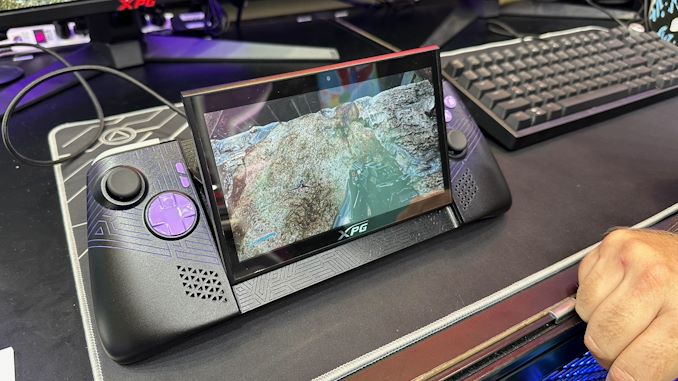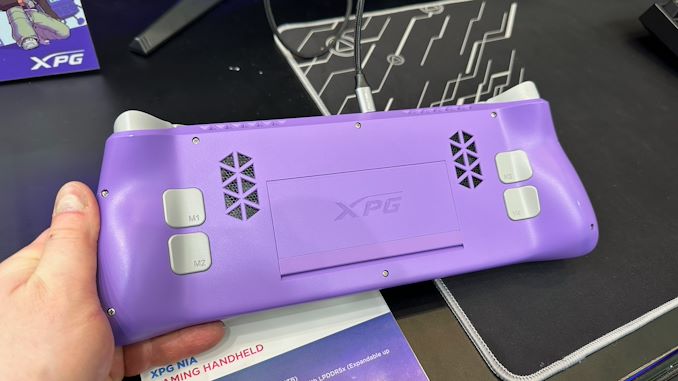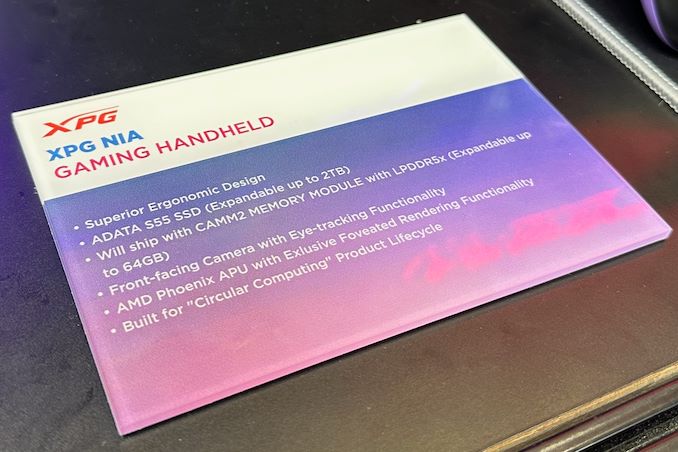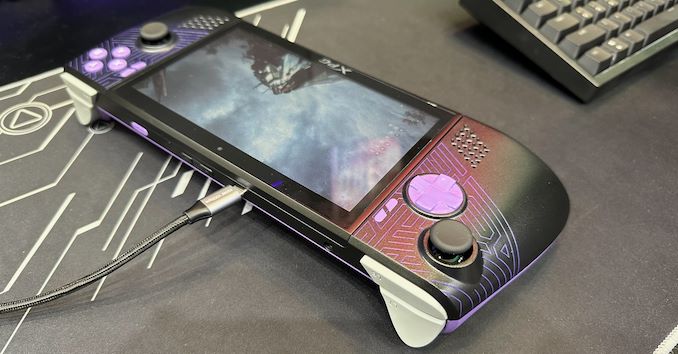XPG Demos "Nia" Handheld Gaming PC With Foveated Rendering, Swappable DRAM
by Anton Shilov on June 5, 2024 12:00 PM EST- Posted in
- ADATA
- AMD
- Trade Shows
- Consoles
- Computex 2024
- Foveated Rendering

With the rise of the handheld gaming PC market, we've seen PC vendors and their partners toy with a number of tricks and tweaks to improve improve framerates in games, with some of their latest efforts on display at this year's Computex trade show. Perhaps the most interesting find thus far comes from ADATA sub-brand XPG, who is demoing their prototype "Nia" handheld PC, which uses eye tracking and dynamic foveated rendering to further improve their rendering performance.
For those unfamiliar, dynamic foveated rendering is a graphics technique that is sometimes used to boost performance in virtual reality (VR) and augmented reality (AR) applications by taking advantage of how human vision works. Typically, humans can only perceive detailed imagery in the relatively small central area of our vision called the fovea, while our peripheral vision is much less detailed. Dynamic foveated rendering, in turn, exploits this by using real-time eye tracking to determine where the user is looking, and then rendering just that area in high/full resolution, while rendering the peripheral areas in lower resolution. The net result is that only a fraction of the screen is rendered at full detail, which cuts down on the total amount of rendering work required and boosting framerates on performance-limited devices.
As stated before, this technology is sometimes used in high-end AR/VR headsets, where high resolution displays are placed mere inches from one's face. This ends up being an ideal use case for the technique, since at those distances, only a small fraction of the screen is within the fovea.
Using dynamic foveated rendering for a handheld, on the other hand, is a more novel application. All of the same visual principles apply, but the resolutions at play are lower, and the screen is farther from the users' eyes. This makes a handheld device a less ideal use case, at least on paper, as a larger portion of the screen is going to be in the fovea, and thus will need to be rendered at full resolution. None the less, it will be interesting to see how XPG's efforts pan out, and if dynamic foveated rendering is beneficial enough for handheld PCs. As we sometimes see with trade show demos, not everything makes it out of the prototype stage.
According to a press release put out by ADATA ahead of the trade show, the eye tracking technology is being provided by AMD collaborator Eyeware. Notably, their software-based approach runs on top of standard webcams, rather than requiring IR cameras. So the camera hardware itself should be pretty straight-forward.
Foveated rendering aside, XPG is making sure that the Nia won't be a one-trick pony. The handheld's other major claim to fame is its hardware swappability. The prototype handheld not only features a removable M.2-2230 SSD, but the company is also taking advantage of the recently-introduced LPCAMM2 memory module standard to introduce removable DRAM. Via a hatch in the back of the handheld, device owners would be able to swap out LPCAMM2 LPDDR5X modules for higher capacity versions. This would give the handheld an additional degree of future-proofness over current handhelds, which use non-replaceable soldered-down memory.
Rounding out the package, the current prototype is based on an AMD's Zen 4 Phoenix APU, which is used across both of the company's current mobile lines (Ryzen Mobile 7000/8000 and Ryzen Z1). Meanwhile, the unit's display is adjustable, allowing it to be angled away from the body of the handheld.
Assuming all goes well with the prototype, XPG aims to release a finished product in 2025.














10 Comments
View All Comments
NextGen_Gamer - Wednesday, June 5, 2024 - link
Correct me if I am wrong on this, but even though your eyes will still be "fully" concentrated on portions of the screen at once, when looking at a handheld display of 7" or 8", won't the entirety of it be within your fovea view at any given time? (I see the article mentions this too)kn00tcn - Wednesday, June 5, 2024 - link
look at your phone (or any screen, book, etc), to my eyes it's still a very small area that's 'clear' and a slight deviation seems incomprehensible when it's text, but it doesnt necessarily seem blurry eitherit's almost as if peripheral vision is in patches (like blender cycles renderer with a denoiser)
nandnandnand - Friday, June 7, 2024 - link
You can test it yourself by focusing on the clock in this image:https://www.theverge.com/2016/7/22/12260430/nvidia...
Even looking at a small image on my small laptop from 2-3 feet away, the effect clearly works. I think the "circle" in which you perceive full quality is probably less than 1% of your vision at any instant. The eye tracking adjusts the foveated rendering in response to your rapid eye movements.
This is something that could work for handhelds and desktop monitors if implemented correctly. It's probably more complicated to do the eye tracking because unlike a headset fixed to your face, you can be moving the handheld and your head independently of each other. FPS might even drop if you move further away. But there's potential for huge performance and battery life gains.
juancn - Wednesday, July 3, 2024 - link
The fovea covers about 5 degrees of really high resolution field of view, and the whole macula covers around 18 degrees. At 50 cm distance, the fovea sees a ~4cm circle and the macula a ~15cm one, so you have a point, but if the quality doesn't degrade a lot, the brain won't notice much.PeachNCream - Wednesday, June 5, 2024 - link
A minor suggestion to update the article's already lengthy title. It should read "XPG Demos "Nia" Handheld Gaming PC With Foveated Rendering, Swappable DRAM, and a Plethora of Journalist Fingerprints"I get that it's been handled a lot for photos and demos but ew that's disgusting! Convention stranger danger finger goo!
Mobile-Dom - Friday, June 7, 2024 - link
eh, tradeshow prototypes usually only have a lifespan of a few weeks to a month or so, adding an oleophobic coating (to make it easier to clean) is an unnecessary extra step and costPeachNCream - Saturday, June 8, 2024 - link
Fair statement but it just looks so touchie-pokey with finger slime that I just want to attack it with a microfibre cloth. I hope Future staff didn't catch a disease.meacupla - Thursday, June 6, 2024 - link
If that screen slid up a little more, like maybe 5cm more, then I think it would be perfectTechie4Us - Monday, June 10, 2024 - link
y/A/w/n...Anutha day, ANUTHA handholder thingy...just moar gammin tois for da gamr bois....
Will this EVER stop, I mean this form factor has been rehashed & rehashed & rehashed again & again already, just let it go, so someone can come up with something new & exciting for once !
nandnandnand - Monday, June 10, 2024 - link
Foveated rendering outside of VR is exciting. Probably should have been done years ago.